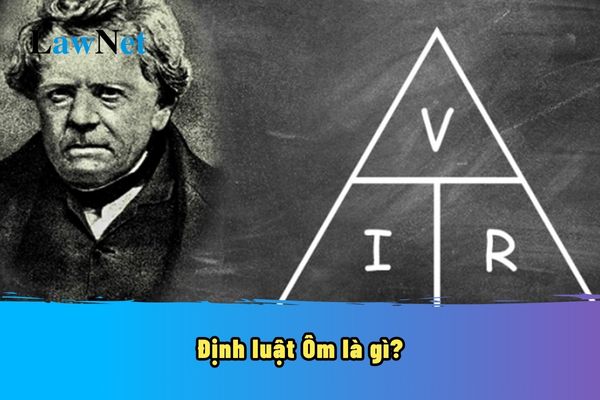What is Ohm's Law? What is the symbol for Ohm in Physics? When do students in Vietnam study Ohm's Law?
What is Ohm's Law? What is the symbol for Ohm in Physics?
Students will learn about Ohm's Law in the Physics curriculum. Let's explore following information:
What is Ohm's Law? What is the symbol for Ohm in Physics?
Ohm's Law is one of the most fundamental and important laws in Physics, especially in the field of electricity. This law describes the relationship between the current flowing through a conductor and the voltage applied across the conductor's two ends.
The content of Ohm's Law:
The current flowing through a conductor is directly proportional to the voltage applied across it and inversely proportional to the conductor's resistance.
Formula:
I = U/R
*Where:
I: Current (unit: amperes, symbol: A)
U: Voltage (unit: volts, symbol: V)
R: Resistance (unit: ohms, symbol: Ω)
*The significance of Ohm's Law:
The higher the voltage, the greater the current through the conductor.
The higher the resistance, the lesser the current through the conductor.
*Note: The information is for reference only./.

What is Ohm's Law? What is the symbol for Ohm in Physics? When do students in Vietnam study Ohm's Law? (Image from Internet)
When do students in Vietnam study Ohm's Law?
According to Section 5, Appendix of the General Physics Program issued with Circular 32/2018/TT-BGDDT, the regulation is as follows:
Content: Circuit and Resistance
Requirements to achieve:
- Define resistance, unit of resistance measurement, and state the main causes of resistance.
- Sketch and discuss the I - U characteristic curve of a metallic conductor at a defined temperature.
- Briefly describe the influence of temperature on the resistance of an incandescent lamp, thermistor.
- State Ohm's Law for metallic conductors.
- Define electromotive force through the energy to move a unit charge around a closed loop.
- Describe the effect of internal resistance of a power source on the potential difference between the source’s terminals.
- Compare electromotive force and potential difference.
- Discuss to design or select a method and execute it, measure the electromotive force and internal resistance of a battery or accumulator using practical tools.
Thus, students will learn Ohm's Law in Grade 11 Physics as an essential content.
What are the 3 main topics to achieve in Grade 11 Physics in Vietnam?
According to Section 5, Appendix of the General Physics Program issued with Circular 32/2018/TT-BGDDT:
Topic 11.1. Gravitational Field:
Concept of gravitational field
- Provide examples demonstrating the existence of the Earth's gravitational force.
- Discuss (using diagrams, multimedia materials) to indicate: Every object with mass creates a gravitational field around it; A gravitational field is a force field created by an object with mass, is a form of matter existing around an object with mass, and exerts gravitational force on objects placed within it.
Gravitational force
- State that when considering a gravitational field at a point outside a homogeneous sphere, the sphere's mass can be considered concentrated at its center.
- Apply Newton's law of gravitation F = Gm1m2/r2 for some simple motion cases in the gravitational field.
Gravitational field strength
- Define gravitational field strength.
- From the law of gravitation and the definition of gravitational field strength, derive the equation g = GM/r2 for simple cases.
- Apply the equation g = GM/r2 to assess some simple gravitational field phenomena.
- State that at every position near the Earth's surface, within a not-so-high altitude range, g is a constant.
Gravitational potential and potential energy
- Discuss (using images, multimedia materials) to define gravitational potential at a point in the gravitational field.
- Apply the equation = - GM/r in simple cases.
- Briefly explain the motion of geostationary satellites, derive the formula to calculate the first cosmic speed.
Topic 11.2. Communication by Radio Waves
Modulation
- Compare amplitude modulation (AM) and frequency modulation (FM).
- List the frequencies and wavelengths used in different communication channels.
- Discuss to point out the relative advantages and disadvantages of AM and FM channels.
Analog and digital signals
- Describe the advantages of transmitting data in digital form over analog form.
- Discuss to conclude: the transmission of voice or music involves analog-to-digital (ADC) conversion before transmission and digital-to-analog (DAC) conversion upon receipt.
- Briefly describe the digital transmission system concerning analog-to-digital and digital-to-analog conversion.
Signal attenuation
- Discuss the impact of signal attenuation on the quality of transmitted signals; state the signal attenuation calculated in dB and per unit length.
Topic 11.3. Introduction to Electronics
Operational Amplification
- Discuss, propose, choose a method and carry out the Project to explore:
+ Classify sensors based on: operating principle, range of use, economic efficiency.
+ Operating principle of: light-dependent resistor (LDR), thermistor.
+ Operating principle of sensor using: light-dependent resistor (LDR), thermistor.
+ Basic properties of the ideal operational amplifier (op-amp).
Output Devices
- Discuss, propose, choose a method and carry out the Project to explore three output devices:
+ Operating principle of op-amp - relays circuit.
+ Operating principle of op-amp - LEDs (light-emitting diode) circuit.
+ Operating principle of op-amp - calibrated meter (CMs) circuit.
+ Design some simple application circuits using output devices.
Sensor Devices
- Visit in reality (or through multimedia materials), discuss to indicate several main applications of sensing devices and the operating principle of sensing devices.

